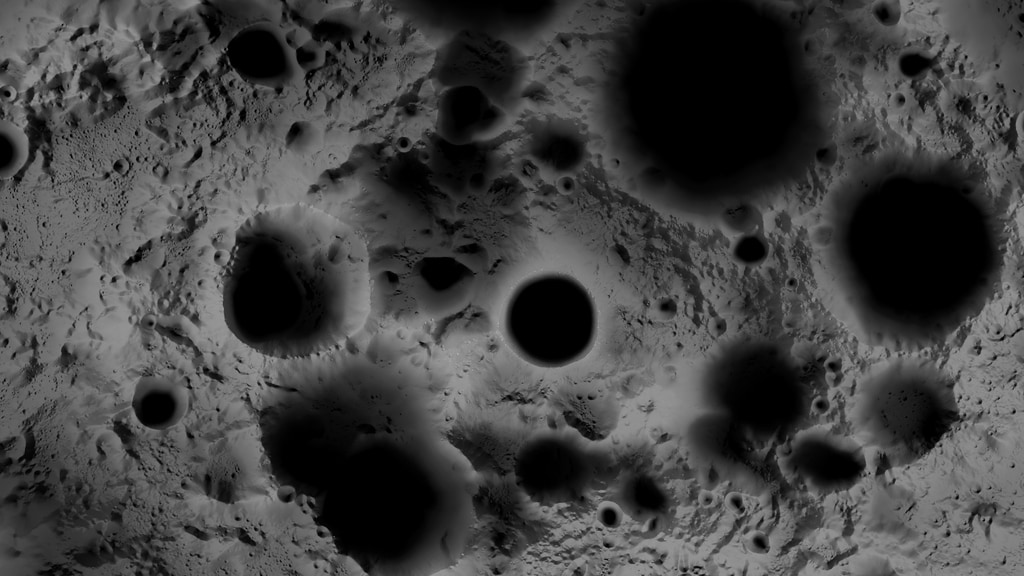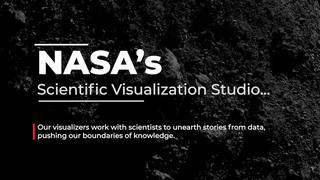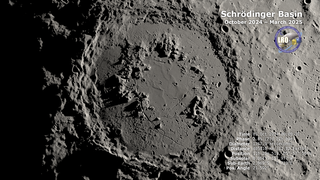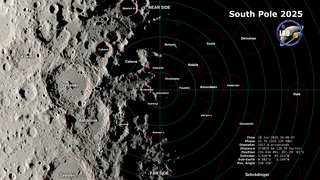Planets and Moons
ID: 4770
The Apollo program landed six pairs of astronauts on the Moon between 1969 and 1972. All six landing sites are at low latitudes, near the equator. In this visualization, the Apollo sites are contrasted with the South Pole, an area with enormous potential for future exploration. Time passes as we zoom toward Shackleton crater at the South Pole, revealing illumination conditions quite different from those near the equator. While many craters remain in permanent shadow, some nearby mountains and ridges are in persistent sunshine, making them attractive candidates for solar power and long-term habitation.
The remaining visualizations on this page show the illumination at the lunar South Pole throughout 2024, at several different scales. The year begins in the middle of South Pole summer, with the subsolar latitude near its greatest southern extent. As the year progresses, the shadows begin to deepen until mid-year and South Pole winter, when the subsolar latitude is at its northern extreme. The full range of the Sun's apparent motion in latitude is only about 3 degrees, versus 47 degrees on Earth, but this is enough to have a substantial effect on the amount of sunlight reaching the lunar poles.

From Apollo Sites To The South Pole
The remaining visualizations on this page show the illumination at the lunar South Pole throughout 2024, at several different scales. The year begins in the middle of South Pole summer, with the subsolar latitude near its greatest southern extent. As the year progresses, the shadows begin to deepen until mid-year and South Pole winter, when the subsolar latitude is at its northern extreme. The full range of the Sun's apparent motion in latitude is only about 3 degrees, versus 47 degrees on Earth, but this is enough to have a substantial effect on the amount of sunlight reaching the lunar poles.

Used Elsewhere In
Related
Visualization Credits
Ernie Wright (USRA): Lead Visualizer
Noah Petro (NASA/GSFC): Scientist
Laurence Schuler (ADNET Systems, Inc.): Technical Support
Ian Jones (ADNET Systems, Inc.): Technical Support
Noah Petro (NASA/GSFC): Scientist
Laurence Schuler (ADNET Systems, Inc.): Technical Support
Ian Jones (ADNET Systems, Inc.): Technical Support
Please give credit for this item to:
NASA's Scientific Visualization Studio
NASA's Scientific Visualization Studio
Short URL to share this page:
https://svs.gsfc.nasa.gov/4770
Data Used:
Note: While we identify the data sets used in these visualizations, we do not store any further details nor the data sets themselves on our site.
Keywords:
SVS >> HDTV
SVS >> Landing Site
SVS >> Moon
SVS >> Hyperwall
SVS >> LRO
SVS >> Lunar Reconnaissance Orbiter
SVS >> Apollo Missions
SVS >> Moon >> South Pole
NASA Science >> Planets and Moons
SVS >> Permanently Shadowed Regions
https://svs.gsfc.nasa.gov/4770
Data Used:
LRO/LOLA/Digital Elevation Map also referred to as: DEM
Lunar Reconnaissance Orbiter/LRO Camera/Natural Color Hapke Normalized WAC Mosaic also referred to as: LROC WAC Color Mosaic
Mosaic - Arizona State University
This natural-color global mosaic is based on the 'Hapke normalized' mosaic from LRO's wide-angle camera. The data has been gamma corrected, white balanced, and range adjusted to more closely match human vision.
Keywords:
SVS >> HDTV
SVS >> Landing Site
SVS >> Moon
SVS >> Hyperwall
SVS >> LRO
SVS >> Lunar Reconnaissance Orbiter
SVS >> Apollo Missions
SVS >> Moon >> South Pole
NASA Science >> Planets and Moons
SVS >> Permanently Shadowed Regions















